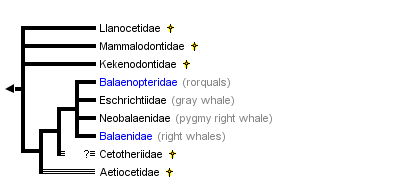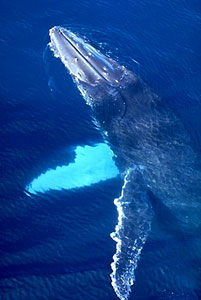Mysticeti
Baleen whales
Michel C. Milinkovitch and Olivier Lambert


This tree diagram shows the relationships between several groups of organisms.
The root of the current tree connects the organisms featured in this tree to their containing group and the rest of the Tree of Life. The basal branching point in the tree represents the ancestor of the other groups in the tree. This ancestor diversified over time into several descendent subgroups, which are represented as internal nodes and terminal taxa to the right.

You can click on the root to travel down the Tree of Life all the way to the root of all Life, and you can click on the names of descendent subgroups to travel up the Tree of Life all the way to individual species.
For more information on ToL tree formatting, please see Interpreting the Tree or Classification. To learn more about phylogenetic trees, please visit our Phylogenetic Biology pages.
close boxIntroduction
All living mysticetes are large filter-feeders although the exact means by which baleens are used vary among species (gulp-feeding for balaenopterids, skim-feeding for balaenids, and bottom ploughing for eschrichtiids).
Characteristics
The morphological modifications linked to filter-feeding are:
- Loss of functional teeth (vestigial teeth are lost before birth),
- Development of large body size and head,
- Shortening of the neck,
- Expanded maxillae (on which the epithelially-derived baleen plates develop),
- Mandibular rami only attached to each other by a ligament (at the symphysis).
Discussion of Phylogenetic Relationships
The relationships among extinct and extant groups of mysticetes have been less extensively studied than the relationships among odontocetes. Four families are currently recognized: Balaenidae, Balaenopteridae, the Neobalaenidae (including a single extant species, the pygmy right whale, Caperea marginata), and the Eschrichtiidae (including a single extant species, the gray whale, Eschrichtius robustus).
Some molecular analyses positioned the skim-feeding balaenids (right whales) as the basal lineage of extant mysticetes (e.g., Arnason and Gulberg, 1994, 1996; Gatesy 1998). Uncertainty remains regarding the phylogenetic position of neobalaenids: Caperea might be the sister group to balaenopterids (rorquals) and Eschrichtius (gray whale) (Arnason and Gulberg 1994), or to balaenids (Gatesy 1998). This latter hypothesis is also supported by the morphological studies of McLeod et al. (1993) and Bisconti (2000).
Discussion of some problematic extinct groups
Several fossil groups of mysticetes (e.g., Aetiocetidae and Cetotheriidae) are still taxonomically problematic; it is very likely that some of them form paraphyletic groups. Systematic revisions, additional anatomical data and cladistic analyses will be required before reaching reasonable hypotheses regarding the phylogeny of these groups.
- The Oligocene family Aetiocetidae (review in Barnes et al. 1994) includes primitive toothed mysticetes (some of them having been erroneously placed within archaeocetes), showing a mix of archaeocete-like and mysticete-like skull features. This family persisted into Late Oligocene, at a time where more derived baleen-bearing whales had already evolved. Specimens have been found on both sides of the North Pacific.
- The fossil specimens from other archaic toothed mysticete families (Llanocetidae, Mammalodontidae, and Kekenodontidae) have not been studied extensively enough to be meaningfully included into phylogenetic analyses. Members of these families, may have used their teeth for bulk feeding rather than for selecting individual preys, but functional studies are needed to confirm this hypothesis (Fordyce and Barnes, 1994).
- Cetotheriidae is a very diverse paraphyletic family of Late Oligocene to Late Pliocene baleen-bearing whales. Many taxa are based on fragmentary material, leading to difficulties when trying to correlate taxa from distant fossil localities. Some cetotheriids exhibit character states reasonably interpreted as ancestral for balaenopterids (Mc Leod et al.1993; Kimura and Ozawa, 2002). Among Cetotheriidae s.l., Bouetel and Muizon (2006) isolate a monophyletic Cetotheriidae s.s., supported by a series of cranial characters and including six genera (Cetotherium, Herpetocetus, Metopocetus, Mixocetus, Nannocetus, and Piscobalaena).
References
Arnason, U. and A. Gullberg. 1994. Relationship of baleen whales established by cytochrome-b gene sequence comparison. Nature 367:726-728.
Arnason, U. and A. Gullberg. 1996. Cytochrome b nucleotide sequences and the identification of five primary lineages of extant cetaceans. Molecular Biology and Evolution 13:407-417.
Barnes, L. G., Kimura, M., Furusawa, H., and Sawamura, H. 1994. Classification and distribution of Oligocene Aetiocetidae (Mammalia; Cetacea; Mysticeti) from western North America and Japan. The Island Arc 3: 392-431.
Bisconti, M. 2000. New description, character analysis and preliminary phyletic assessment of two Balaenidae skulls from the Italian Pliocene. Palaeontographia Italica 87: 37-66.
Bouetel, V. and Muizon, C. de, 2006. The anatomy and relationships of Piscobalaena nana (Cetacea, Mysticeti), a Cetotheriidae s.s. from the early Pliocene of Peru. Geodiversitas 28(2): 319-395.
Fordyce, R. E. 1981. Systematics of the odontocete whale Agorophius pygmaeus and the family Agorophiidae (Mammalia: Cetacea). Journal of Paleontology 55(5): 1028-1045.
Fordyce, R. E. 2002. Simocetus rayi (Odontoceti: Simocetidae) (new species, new genus, new family), a bizarre new archaic Oligocene dolphin from the eastern North Pacific. Smithsonian Contributions to Paleobiology 93: 185-222.
Fordyce, R. E. and L. G. Barnes. 1994. The evolutionary history of whales and dolphins. Annual Review of Earth and Planetary Sciences 22:419-455.
Gatesy, J. 1998. Molecular evidence for the phylogenetic affinities of Cetacea. pp. 63-112 in: Thewissen J.G.M. (ed.), The Emergence of Whales: Evolutionary Patterns in the Origin of Cetacea , Plenum, New York.
Kimura, T. and Ozawa, T. 2002. A new cetothere (Cetacea: Mysticeti) from the Early Miocene of Japan. Journal of Vertebrate Paleontology 22(3): 684-702.
McLeod, S. A., Whitmore, F. C., Jr., and Barnes, L. G. 1993. Evolutionary relationships and classification. pp. 45-70 in: Burns, J. J., Montague, J. J., and Cowles, C. J. (eds). The Bowhead whale, The Society for Marine Mammalogy, Special Publication, 2.
Nikaido, M., H. Hamilton, H. Makino, T. Sasaki, K. Takahashi, M. Goto, N. Kanda, L. A. Pastene, and N. Okada. 2006. Baleen Whale Phylogeny and a Past Extensive Radiation Event Revealed by SINE Insertion Analysis. Mol. Biol. Evol. 23:866–873.
Rothausen, K. 1968. Die systematische Stellung der europäischen Squalodontidae (Odontoceti, Mammalia). Paläontologische Zeischrift 42: 83-104.
Rychel, A. L., T. W. Reeder, and A. Berta. 2004. Phylogeny of mysticete whales based on mitochondrial and nuclear data. Mol. Phylogenet. Evol. 32:892–901.
Sasaki, T., M. Nikaido, H. Healy et al. 2005. Mitochondrial phylogenetics and evolution of mysticete whales. Syst. Biol. 56:77–90.
Information on the Internet
- Whale Acoustics Project. NOAA's National Marine Mammal Laboratory in Seattle, Washington and Pacific Marine Environmental Laboratory in Newport, Oregon.
- The Origins and Adaptations of Mysticetes. Robert Ewan Fordyce, University of Otago, New Zealand.
Title Illustrations

| Scientific Name | Megaptera novaeangliae |
|---|---|
| Location | Gerlache Strait (Antarctica) |
| Comments | Humpback whale (Balaenopteridae). |
| Creator | Photograph by Gerald and Buff Corsi |
| Specimen Condition | Live Specimen |
| Source Collection | CalPhotos |
| Copyright |
© 2001 California Academy of Sciences

|
About This Page
Michel C. Milinkovitch

Genetics & Evolution, University of Geneva
Olivier Lambert

Royal Institute of Natural Sciences (Belgium)
Correspondence regarding this page should be directed to Michel C. Milinkovitch at
Page copyright © 2006 Michel C. Milinkovitch
All Rights Reserved.
- Content changed 07 August 2006
Citing this page:
Milinkovitch, Michel C. and Olivier Lambert. 2006. Mysticeti. Baleen whales. Version 07 August 2006 (under construction). http://tolweb.org/Mysticeti/16024/2006.08.07 in The Tree of Life Web Project, http://tolweb.org/







 Go to quick links
Go to quick search
Go to navigation for this section of the ToL site
Go to detailed links for the ToL site
Go to quick links
Go to quick search
Go to navigation for this section of the ToL site
Go to detailed links for the ToL site